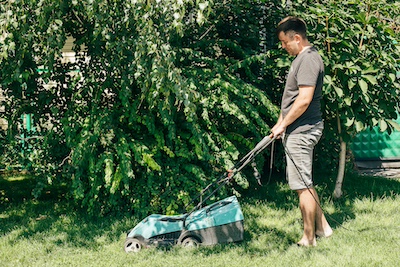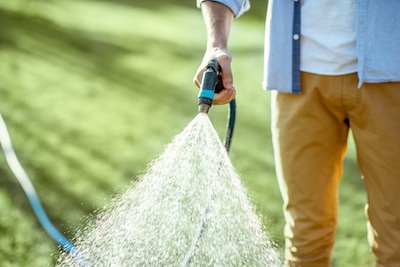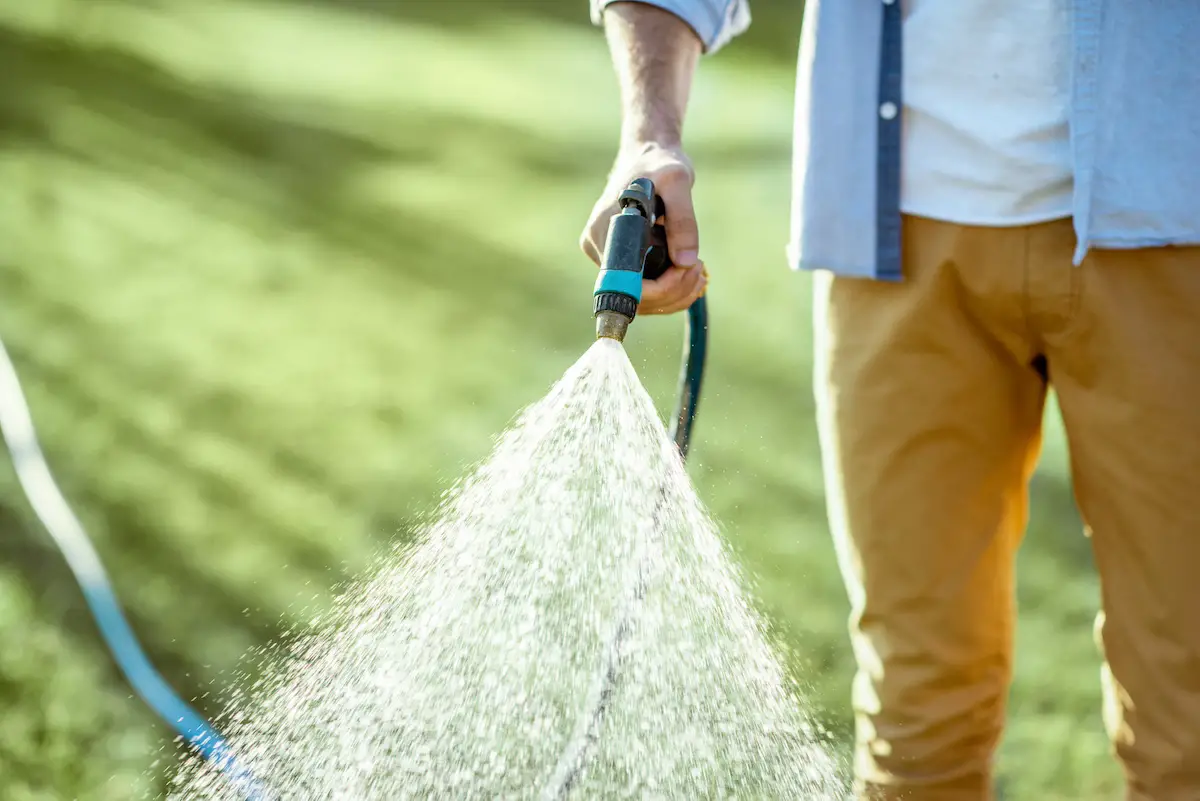Watering Your Lawn in Summer
Ensuring your lawn receives the right amount of water during your summer lawn care routine is crucial for its health. Generally, your grass requires about an inch of water per week, including rainfall. Keep an eye on local weather reports and adjust your watering schedule accordingly.
Watering early in the morning is most effective, as it allows water to soak into the soil before the sun’s intense rays can evaporate it. Watering in the evening risks leaving your grass damp overnight, which can invite fungal diseases.
To check if you’re giving your lawn enough water, try the screwdriver test:
- Push a screwdriver into the soil shortly after watering.
- If it goes in easily up to about six inches, you’ve watered enough.
- If not, your lawn probably needs more hydration.
For those using sprinklers, placing several containers around your lawn and running your sprinklers for about 15 minutes can ensure accuracy in watering. Measure the water in each container with a ruler to see if you’re hitting that inch-per-week target and if your sprinkler system is distributing water evenly across your lawn.
Adjust your strategy based on the type of grass you have. Warm-season grasses might require more frequent watering compared to cool-season varieties, especially during peak summer months.
Consider installing a smart irrigation system or timers for efficiency. These tools can remove guesswork, automatically adjusting watering based on real-time weather conditions, ensuring your lawn gets precisely what it needs without waste.
Following these steps should ensure your lawn remains lush and healthy all summer long.

Mowing Techniques for Summer Lawn Care
Mowing your lawn during the summer can feel like a straightforward task, but employing the right strategies can make a significant difference in maintaining a lush, healthy turf.
Consider the height of your grass. Never chop off more than one-third of the grass blade during a mowing session. Cutting your grass too short can stress it, making it susceptible to weeds and pest infestations.
For most lawns, keeping the grass at a height of around 3 inches is ideal. This height helps promote root growth and retain soil moisture, two critical factors during the hot summer months.
Mowing frequency is equally important. Let the growth and condition of your grass guide you. During periods of rapid growth, you might find yourself mowing once a week or more frequently.
However, during extreme heat or dry conditions, grass growth may stall, requiring less frequent mowing. Adapt to changing conditions rather than sticking to a rigid schedule.
Sharp mower blades are an often overlooked aspect of lawn care that can significantly impact the health of your summer lawn. Dull blades tear at grass, creating jagged edges that are more prone to disease and can give your lawn a grayish-brown tint.
Ensure your mower blades are sharp to cut the grass cleanly, which promotes healthier growth and a greener lawn.
Clippings management is another strategy worth considering. Leaving clippings on the lawn can be beneficial, as they decompose quickly and return valuable nutrients to the soil.
If you’re concerned about clumps that smother the grass, use a mower with a mulching function to cut the clippings into fine pieces that distribute evenly and decompose more rapidly.
Vary your mowing patterns. Mowing in the same direction every time can compact the soil and cause the grass to grow at an angle, making it look uneven over time.
By alternating your mowing paths—going horizontal one week, vertical the next, and diagonal after that—you encourage more upright growth and reduce soil compaction.
Implementing these strategies for summer lawn care can lead to a robust, lush lawn that’s better equipped to handle the stresses of summer heat and activity. Prioritize the health of your grass with thoughtful mowing practices, and enjoy the green, inviting outdoor space you’ve cultivated.

Managing Pests and Weeds During Summer Lawn Care
Managing pests and weeds during the summer can be a daunting task. Typically, both thrive in warm conditions and without proper management, they can quickly take over your lawn. However, with the right measures in place, it’s possible to keep these unwelcome guests at bay without harming your turf.
Identification is key. Understand what types of pests and weeds are common in your area during the summer.
Common lawn pests include grubs, chinch bugs, and sod webworms, while weeds might range from crabgrass to dandelions. Recognizing them early on can help you adopt targeted approaches to deal with them effectively.
For pests, introducing beneficial insects like ladybugs or parasitic nematodes into your lawn can be a natural and effective approach. These allies help control pest populations naturally, diminishing the need for chemical insecticides that could harm your lawn or the environment.
Implementing a preemergent herbicide in the late spring or early summer can prevent weeds before they start. This method stops weed seeds from germinating, making future management easier.
For weeds that have already sprouted, spot treatment with a post-emergent herbicide can be effective. Select a herbicide labeled for use on the particular weed you’re targeting and apply it according to the directions to avoid damaging your lawn.
Cultural practices play a crucial role as well. Maintaining a healthy lawn can naturally discourage pest and weed infiltration. Thick, vigorously growing grass leaves little room for weeds to establish.
Adjusting soil pH to meet the needs of your specific grass type can improve lawn health. Regular aeration helps the soil breathe and improves water penetration, further strengthening your lawn against pests and weeds.
Regularly inspect your lawn for signs of distress, such as discolored patches or wilting, as these may indicate pest activity. Early detection makes control measures more effective and less harmful to the rest of your lawn.
For organic management, consider using corn gluten meal in the spring. This natural product works as both a preemergent weed control and a nitrogen-rich fertilizer, supporting your lawn’s health while warding off weeds.1
In dealing with both pests and weeds, moderation is critical. Overuse of any treatment, even organic options, can cause more harm than good. Always adhere to the recommended application rates and timings suggested by product labels or professional guidelines.

Creating a Summer Lawn Care Routine
By implementing these strategies, you can effectively manage pests and weeds in your lawn during the summer months. With proactive measures and an emphasis on lawn health, you’ll maintain a vibrant outdoor space that’s both beautiful and healthy without relying heavily on harmful chemicals.
- Bingaman B, Christians NE. Greenhouse screening of corn gluten meal as a natural control product for broadleaf and grass weeds. HortScience. 1995;30(6):1256-1259.

